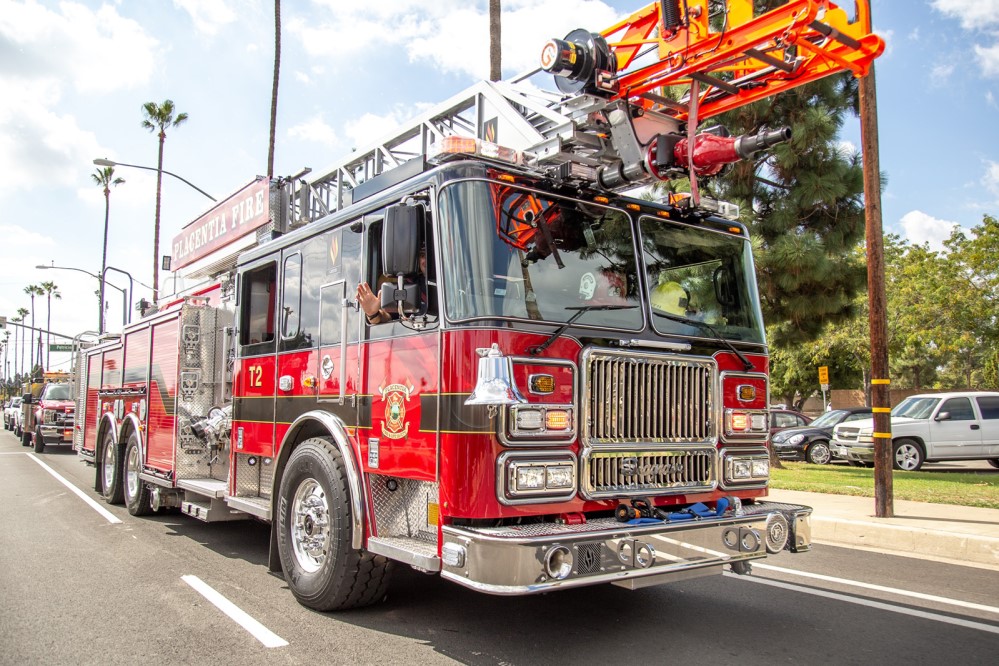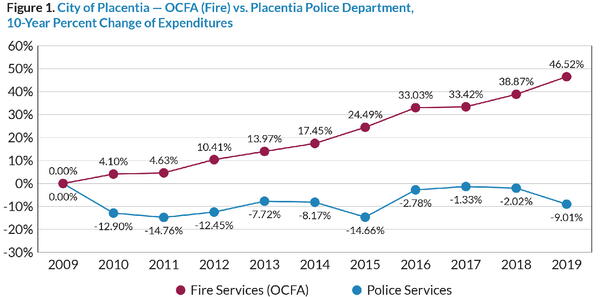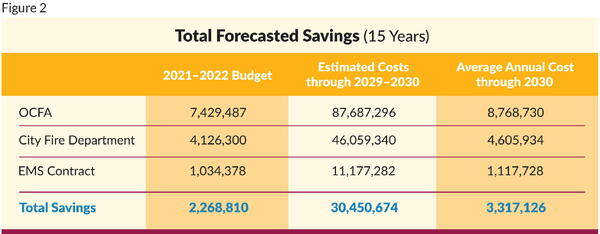
Long-term solutions to fiscal sustainability drove Placentia’s need to reevaluate its fire and EMS service model.
In 1975, the original Placentia Fire Department was disbanded, and the city of Placentia began contracting with Orange County for fire protection and paramedic services. In the wake of the Orange County bankruptcy of 1995, the Orange County Fire Department was separated from the county structure and spun off into a new joint powers authority (JPA) agreement. Placentia became a founding member of the JPA as a “cash contract” city. For the next 25 years, the Orange County Fire Authority (OCFA) provided fire protection and emergency medical services (EMS) to the Placentia community out of two city-owned fire stations.
The OCFA JPA agreement among the member cities is structured in such a way that allows the agency to raise its rates on cash contract cities every year by 4.5%, year after year, regardless of any change or improvement to service levels or economic conditions. Regional service provider contracts like these typically require a one-size-fits-all approach, which does not allow cities to customize their service levels based on their actual risk profile, resulting in higher rather than reduced costs for contract cities. The loss of local control over these critical services essentially prevents cities from exercising any long-term cost controls, nor does it allow for improving the quality of services provided or innovation in delivering those services in new ways.
Since 2009 and through the Great Recession of the late 2000s, OCFA had increased the cost to provide fire and EMS to Placentia by 47% while providing no increases in service levels. Essentially, the cost to staff two Type I fire engines responding to emergencies out of two fire stations was growing by nearly double the rate of inflation every year. Simultaneously, the city cut services to the community and deferred much needed infrastructure repairs to afford these cost increases.
In addition, within the same 10-year period, the Placentia Police Department’s budget shrank by 9% and the city’s general fund budget for all departments increased by only 12%. This represents a 57% difference in increases between the city’s two public safety service operations—police and fire—despite police handling a much larger call volume.
Such a large increase, when compared to the remainder of the city’s full-service operations and departments, was far outstripping the city’s ability to absorb these costs. This warranted a complete re-evaluation of fire and EMS service delivery options for our community. As we began that journey, we determined our main objectives for the process:
- Implement a financially sustainable and responsible service model.
- Reduce emergency response times.
- Build a resilient service model that reduces reliance on mutual aid from surrounding communities.
- Improve the overall quality of both services.

Placentia’s service model was created by analyzing service call data and the city’s actual risk profile. EMS is a healthcare function, not a public safety function.
Southern California was ground-zero in the early 1970s for the first paramedic programs in the state. Started by hospitals and employing private ambulance companies, the earliest paramedic programs were created by emergency room physicians who developed medical protocols to provide pre-hospital medical services to patients in the field, which were based in part on lessons learned in combat medicine in Vietnam.
At the same time, new development codes to make structures safer during earthquakes, and new technologies such as fire sprinkler systems, were quickly evolving and being adapted to make buildings safer. As a result, the number of fires and large-scale conflagrations experienced in urban areas were vastly reduced.
Consequently, the fire service in California assumed a larger role in providing paramedic services to maintain and justify its staffing levels and operating budgets. Today, the vast majority of fire department 911 emergency calls for service are for EMS. In fact, nearly 80% of the emergency calls to OCFA in Placentia for 2019 were for medical purposes, and very few (less than 1%) were for fighting fire.
Additionally, most EMS calls were at the basic life support (BLS) level, as only 30% of EMS calls for service were for high-acuity medical events (ALS), such as cardiac arrest, strokes, gunshot wounds, and traumatic injuries.
Understanding this dynamic, the city set out to develop a new service model that better reflected the city’s actual risk profile and actual service needs and allowed for a more intelligent deployment of public safety resources. The city understood early on that bifurcating fire and EMS would not only allow both services to be delivered in a much more cost-effective manner, but also improve overall quality by allowing the fire department to focus their efforts on fire protection and prevention, and by allowing paramedics to focus their efforts on EMS.
The traditional fire service model in California continues to utilize an engine company or a truck company to respond to all medical emergencies—and the method of deployment is to triage all medical calls as ALS, regardless of the patient’s condition. As such, a bee sting generates the same level of EMS response as a gunshot wound. However, the city still needed to gain a deeper understanding of the full scope and scale of the services provided by the OCFA by analyzing its service call data. With that in mind, the city engaged the services of the Center for Public Safety Management (CPSM) to complete a detailed workload analysis report, which summarized the overall services received by the city from its contracted provider.
Utilizing an entire year’s worth of computer-aided dispatch (CAD) data provided by OCFA, CPSM was able to complete a deep dive of the full scale of emergency responses provided by OCFA working out of both city fire stations. This analysis offered the clearest picture of the full scope and nature of emergency calls for services provided to the city, as well as a much deeper understanding of the city’s actual risk exposure. Ultimately, this allowed Placentia to coalesce around a new service model that bifurcates both services.
Understanding that the bulk of the work provided by OCFA was EMS, the city’s service model provides for a municipal fire department focused on fire prevention and life safety services, and a separate service contract with a private EMS service provider focused on providing 911/advanced life support (ALS) paramedic services. Although separate entities, both work and train together daily and the city’s paramedic service provider is posted in and responds out of the city’s two fire stations. Placentia was the first city in Orange County to contract with a private provider for 911/ALS even though private paramedics provide these same services in 56 out of 58 California counties and throughout the rest of the United States.
Progressing from workload analysis to requests for proposals.
To objectively evaluate all of its potential options for the bifurcated delivery of fire protection and EMS services, the city developed and issued two comprehensive Requests for Proposals (RFPs)—one for fire protection, prevention, and investigation services; and one for 911/ALS. The RFPs were designed to solicit competitive proposals from the open market (public and private) to better evaluate all options available to Placentia and its residents. These RFPs and the method to procure these services were the first of their kind in Orange County. The city’s proposal to send ambulances staffed by two single-role paramedics to medical calls instead of four firefighters riding on a 55,000-pound fire engine or 75,000-pound fire truck was considered radical at the time, even though this model is used throughout the state and is the predominant service model throughout the country.
An RFP review committee comprised of local leaders and subject matter experts was established to review the proposals and make a recommendation to the city council. Fire protection proposals were received from neighboring cities, and city staff prepared and submitted a competitive proposal on behalf of the city to form the Placentia Fire and Life Safety Department. Based on the recommendation from the committee to proceed with establishing a city fire department and enter into an agreement with a private paramedic service provider, the Placentia City Council voted in 2019 to establish the Placentia Fire and Life Safety Department and awarded a contract to Lynch EMS for 911/ALS.
Over the course of the following year, the city hired, equipped, and trained a modern fire department, launched a new EMS program in partnership with Lynch, and completely retooled the city’s 911 dispatch center into an all-hazard emergency communication center—all during the height of the COVID-19 pandemic. The Placentia Fire and Life Safety Department and Lynch EMS took command at 8:00 a.m. on July 1, 2020, and by 8:20 a.m., they had been dispatched to their first fire—a small kitchen fire that was quickly extinguished.
Placentia’s new service model has resulted in vastly reduced response times and mutual aid assistance and is saving the city approximately $3 million per year in general fund operating costs.
The city’s new fire department staffs its heavy fire apparatuses with a three-person full-time company and one reserve firefighter when available. In addition, the city utilizes a complement of part-time firefighters in backfill capacities to reduce overtime expenditures, thus significantly reducing long-term operating costs.
In addition, when designing the department, the city took the unique and forward-thinking step of ensuring that the retirement benefits provided to the new employees are sustainable over the long term. To that end, Placentia was the first city in Orange County to offer public safety personnel a defined contribution 457 plan, thus saving significantly on upfront and long-term pension debt costs. The city’s 911/ALS service provider staffs two ambulances with four paramedics 24 hours a day, with a third reserve ambulance and crew to provide surge capacity as needed, at a cost of over just $1 million per year.
What is also important to note about the city’s service model is how resilient it is and how little mutual aid is needed on a day-to-day basis from our neighbors. Because the city does not send its firefighters to the hospital with patients, they are thus kept in service and available to respond to emergencies over longer stretches of time than neighboring agencies. The practice of “wall time,” which affects all fire departments in Orange County, essentially takes a fire apparatus and crew out of service while they are waiting against the wall in the hospital to hand off their patient to a nurse or physician. This practice often creates unnecessary overtime and draws down resources from surrounding fire stations to backfill the unit waiting at the hospital.
Using a private EMS provider with an existing infrastructure provides for an extensive surge capacity in Placentia for multi-casualty incidents and other large-scale emergencies. This resilience in our service model was proven in October 2020, as two separate wildfires burned in North Orange County at the same time. We watched in real-time as fire suppression units were being sent by our neighboring agencies from far away distances to respond to medical emergencies because the fire suppression units who would ordinarily be dispatched to those medical calls were occupied working the fire lines. In Placentia, our medic units continued to respond to medical emergencies during these fires without having to request mutual aid assistance from our neighbors and delay emergency response and patient care as a result. System resilience is achieved only by bifurcating fire and EMS services.
Overall, the transition, implementation, and performance of Placentia’s new fire and EMS service model has exceeded the city’s and community’s expectations. When the city began this process, we were unaware of just how out of balance the reciprocal automatic/mutual aid system was between Placentia’s neighbors and OCFA, which saw the municipal fire departments backfilling OCFA response areas by a ratio of 60% to 40%. As a result, the call volume for Placentia units was unexpectedly higher after July 1, 2020. However, Placentia units today are handling 40% more calls than OCFA units had handled, which has only been possible because of our system’s resilience, as previously described.
More tellingly, our service model has reduced mutual aid assistance into Placentia by more than 80%! However, most importantly, we have reduced emergency response times by an average of 3 minutes. In a business where every second counts, the new service model’s response times have far exceeded expectations. Our Lynch paramedics were credited with 14 cardiac saves in our community of 51,000 residents in their first year of operation. This success can also be attributed to sending ambulances instead of fire suppression apparatuses to respond to medical emergencies, stationing the city’s 911/ALS provider inside the city’s fire stations, and the city’s investment in emergency vehicle traffic signal preemption devices, which are also used by our police department, reducing their response times as well.
As illustrated in Figure 2, over the next 15 years, Placentia is projected to save approximately $30 million in general fund dollars with the establishment of its own locally controlled fire department and privatized EMS program.

While the data clearly demonstrates the success and efficacy of the city’s service model, on May 20, 2022, the Orange County Grand Jury issued a report specifically calling out Placentia’s model as a new and better approach to EMS. In its report titled, “Where’s the Fire? Stop Sending Fire Trucks to Medical Calls,” the Orange County Grand Jury conducted an in-depth investigation and analysis of Orange County’s EMS system interviewing OCFA leadership, fire chiefs inside and outside of Orange County, city managers, personnel from Orange County EMS, and private ambulance company executives, as well as fire union leadership. The Grand Jury’s report validated the city’s data and approach and most of the recommendations the Grand Jury made in the report have already been implemented in Placentia. The Grand Jury also singled out the city in its report with a special commendation for innovation in the face of concerted opposition.
Placentia’s success was rooted in the city council’s and city administrator’s implicit trust in one another and staying true to the commitment that this effort was being pursued for the right reasons and for the betterment of the community. No matter how politically challenging Placentia’s desire to change the status quo became at times, the team did not stray from its mission. We put our faith in the process and allowed data, transparency, and continuous communication with the community, and common sense to determine our path forward. The results and recognition clearly speak for themselves.
Key Takeaways
• Bigger is not always better. Contracting with a regional fire protection service provider requires a one-size-fits-all service model, it always costs more with no control over service levels or quality, and there is little incentive for innovation or adaptability.
• Analysis of Computer Aided Dispatch (CAD) and workload analysis data is critical in understanding your community’s actual risk profile and developing a new service model.
• Separating fire protection and prevention services from emergency medical services reduces cost, reduces response times, and improves the overall quality of both services.
• EMS is a healthcare function, not a public safety function.
LUIS ESTEVEZ is deputy city administrator of Placentia, California.

New, Reduced Membership Dues
A new, reduced dues rate is available for CAOs/ACAOs, along with additional discounts for those in smaller communities, has been implemented. Learn more and be sure to join or renew today!
